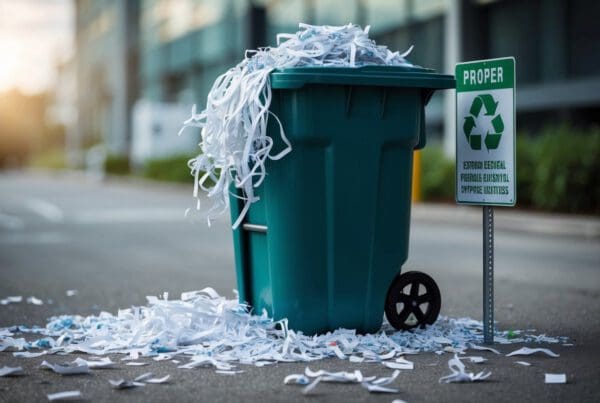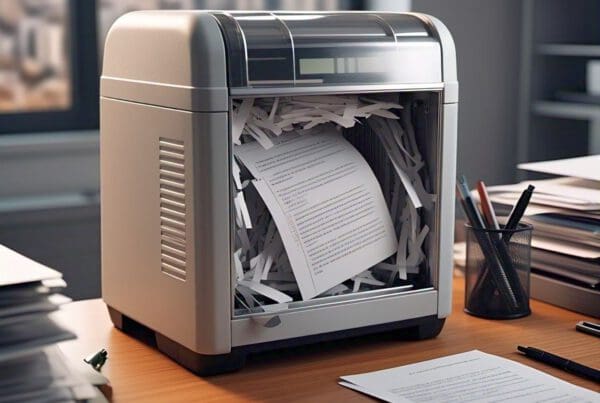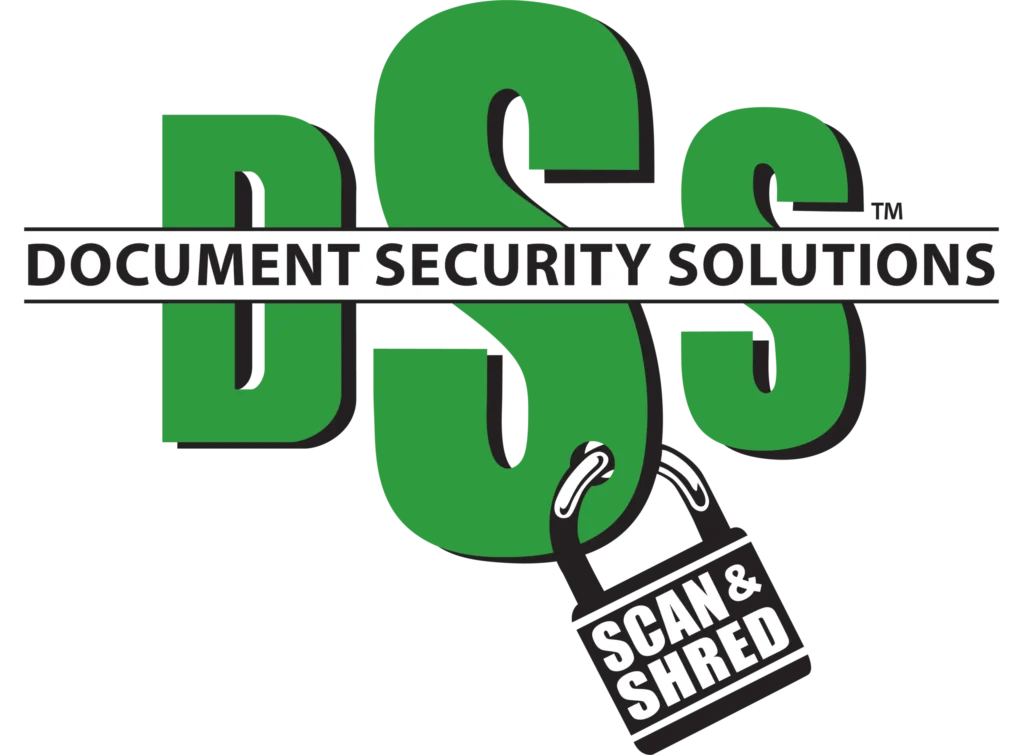Fundamentals of Secure Document Destruction

Secure document destruction plays a critical role in protecting privacy and ensuring information security. It involves safe methods to dispose of sensitive documents and data to prevent unauthorized access.
Understanding Document Destruction
We focus on methods like shredding, degaussing, and physical destruction. Shredding breaks down paper documents into tiny pieces, making them unreadable. For digital data on hard drives, degaussing uses magnetic fields to erase data entirely. Physical destruction, like smashing hard drives, ensures that data cannot be retrieved.
Document destruction processes are vital to protect confidential information such as legal documents and intellectual property. Following these processes helps maintain data security and prevents data breaches. Consistent procedures must be in place to handle sensitive materials safely and compliantly.
Types of Documents and Data to Secure
We must secure a range of documents and data that contain sensitive information. These include legal documents and records holding confidential information. Businesses often manage data related to intellectual property that requires protection through secure destruction methods.
Beyond paper, digital forms like hard drives and storage media need thorough data destruction. Overwriting data may not always be sufficient, thus emphasizing the need for robust destruction processes. Incomplete destruction can lead to significant security risks, highlighting the importance of comprehensive security measures.
Legal and Regulatory Aspects of Data Disposal
In handling data disposal, it is crucial to adhere to legal and regulatory standards to safeguard sensitive information. Understanding these regulations helps us ensure compliance and avoid potential penalties.
Global Data Protection Regulations
Data protection laws around the world, such as the General Data Protection Regulation (GDPR), play a key role in how we manage data disposal. The GDPR requires us to handle personal data responsibly and securely, demanding strict compliance.
These regulations outline clear procedures for data destruction, emphasizing the importance of confidentiality and accuracy. By following these guidelines, we can reduce legal risks and maintain customer trust, proving our commitment to data security.
Compliance and Legal Repercussions
Compliance is not just a recommendation; it’s a legal requirement. Failing to comply with data protection laws can lead to severe repercussions, including fines and legal action. For instance, non-compliance with GDPR can result in hefty fines.
We must ensure proper documentation and obtain a Certificate of Destruction to prove that data was destroyed securely. Regular audits help us stay on track, ensuring our practices align with the required standards and protect us from legal challenges.
Health Insurance Portability and Accountability Act (HIPAA)
The Health Insurance Portability and Accountability Act (HIPAA) is critical for organizations handling health data in the US. HIPAA sets strict standards for data protection, requiring us to follow specific procedures for data disposal to protect patient privacy.
Our focus should be on securely destroying health records and maintaining documentation, as non-compliance could lead to significant penalties. By adhering to HIPAA, we demonstrate our respect for patient confidentiality and commitment to maintaining high standards in data management.
Risks and Consequences of Improper Document Management

Improper document management can lead to severe risks including data breaches and identity theft, substantial financial and reputational damage, and the erosion of customer trust and confidentiality. It is crucial to understand these risks to protect both businesses and their customers.
Cases of Data Breaches and Identity Theft
Data breaches often occur when sensitive documents are not secured properly. This can lead to unauthorized access, exposing confidential information. Once bad actors gain access, identity theft becomes a real threat.
We need to protect both digital and physical documents to prevent these breaches. The consequences can be severe, affecting countless individuals whose personal data is compromised.
Financial and Reputational Damage
When a data breach happens, the financial impact can be substantial. Companies might face fines, legal fees, and compensation payments. These expenses can add up quickly, draining resources that could be used elsewhere.
The reputational damage can be equally harmful. Once trust is broken, customer loyalty tends to wane. That loss of trust may take years to rebuild, if it can be restored at all.
Ensuring Customer Trust and Confidentiality
Maintaining customer trust is closely tied to how we manage documents. Clients expect their information to remain private and secure. When we protect their data, we demonstrate reliability and integrity in handling sensitive information.
It’s our responsibility to ensure confidentiality through stringent security measures. By doing so, we not only meet regulatory obligations but also strengthen relationships with our customers.
Best Practices in Secure Document Destruction
We focus on methods for safely destroying documents to protect sensitive information. We emphasize industry standards, the importance of audits for accountability, and effective document retention and destruction policies.
Destruction Practices and Industry Standards
Proper document destruction is essential for protecting sensitive information. Shredding is a common practice, using machines that slice paper into tiny pieces. It’s important to follow industry standards, which guide us on how small the pieces should be to ensure security.
Other methods include pulping and incineration. Pulping mixes shredded paper with water and chemicals to destroy the paper fiber. Incineration burns paper into ash. Each technique serves different needs depending on the volume and sensitivity of the data.
To ensure secure destruction, we need a well-defined chain of custody. This means keeping a record of who handled the documents from collection to destruction. This process builds trust and verifies that no unauthorized access occurred.
Implementing Regular Audits and Accountability
Regular audits are essential for maintaining accountability. We should schedule audits frequently to ensure processes are secure and followed correctly. Our audits often check if all documents meant for destruction have been properly handled.
Maintaining strict logs of document handling helps during audits. Logs should include dates, times, and names of everyone involved. This keeps everyone accountable and minimizes the risk of errors or mishandling.
To improve consistency, we need staff training. Training helps team members follow the best practices and ensures everyone understands their roles. It also reinforces the importance of data security and the potential consequences of lapses.
Designing Document Retention and Destruction Policies
Well-planned policies are crucial for efficient document management. We first identify the types of documents and determine how long they should be kept. Our policies should consider legal and regulatory requirements about retention periods.
After deciding on retention times, we set clear guidelines for systematic destruction. This includes specifying methods like shredding or pulping and timelines for when destruction should occur post-retention.
Using digital logs to track document lifecycle aids in compliance and transparency. These logs make it easier to monitor documents from creation to destruction, ensuring nothing is missed.
Eco-friendly Secure Destruction and Data Handling
When dealing with confidential documents, it’s crucial to balance security with environmental responsibility. This involves recycling papers safely and handling e-waste from electronic devices.
Recycling and Environmental Responsibility
Shredding documents isn’t just about security; it’s also about being eco-conscious. We should ensure shredded materials are recycled properly, which helps to reduce waste and promote sustainability.
Recycling companies often specialize in processing shredded paper. By partnering with these firms, we can ensure our shredded documents are transformed into new products. This approach not only protects sensitive information but also lessens our environmental impact.
Choosing partners who prioritize environmental responsibility is key. They offer compliance with recycling standards and maintain eco-friendly practices, ensuring that we stick to legal compliance and contribute positively to the environment.
Handling E-Waste from Electronic Devices
E-waste presents a unique challenge since electronic devices, such as smartphones and computers, contain sensitive data. Proper disposal ensures data protection and supports eco-friendly practices.
When dealing with e-waste, it’s essential to use certified recycling centers. These facilities follow strict practices to safely dismantle electronic components, ensuring data is unrecoverable.
Implementing access controls helps keep sensitive data safe during transportation to recycling centers. Responsible handling protects privacy while reducing electronic waste. Mitigating risk through certified recyclers supports both information security and environmental goals. Prioritizing the selection of recyclers who follow environmental laws helps us ensure legal compliance and reduces the impact of e-waste.





